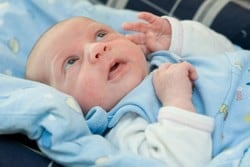If you’re happy and you know it, clap your hands! That’s easy enough for children to figure out because the emotion matches the movement. But when feelings and reactions don’t align, can kids tell there’s something wrong? New research from Concordia University proves that they can — as early as 18 months.
In a study recently published in Infancy: The Official Journal of the International Society on Infant Studies, psychology researchers Sabrina Chiarella and Diane Poulin-Dubois demonstrate that infants can detect whether a person’s emotions are justifiable given a particular context. They prove that babies understand how the meaning of an experience is directly linked to the expressions that follow.
The implications are significant, especially for caregivers. “Our research shows that babies cannot be fooled into believing something that causes pain results in pleasure. Adults often try to shield infants from distress by putting on a happy face following a negative experience. But babies know the truth: as early as 18 months, they can implicitly understand which emotions go with which events,” says psychology professor Poulin-Dubois.
To perform the research, she and PhD candidate Sabrina Chiarella recruited 92 infants at the 15 and 18-month mark. In a lab setting, the babies watched as an actor went through several scenarios in which emotional reactions went with or against pantomimed experiences (for more, see the related video). In one scenario, the researcher showed a mismatched emotion by being sad when presented with a desired toy. In another, she expressed an emotion that went with the experience by reacting in pain when pretending to hurt her finger.
At 15 months, the infants did not show a significant difference in reactions to these events, showing empathy through their facial expressions to all sad faces. This indicates that the understanding of the link between a facial expression following an emotional experience is an ability that has yet to develop at that stage.
At 18 months, however, the infants clearly detected when facial expressions did not match the experience. They spent more time looking at the researcher’s face and checked back more frequently with the caregiver in the room with them so that they could gauge the reaction of a trusted source. They also showed empathy toward the person only when her sad face was justified; that is, only when the researcher was sad or in pain when she was supposed to be.
Chiarella explains that the indiscriminate show of concern to sad faces in the younger infants is an adaptive behaviour. “The ability to detect sadness and then react immediately has an evolutionary implication. However, to function effectively in the social world, children need to develop the ability to understand others’ behaviours by inferring what is going on internally for those around them.”
The researchers are currently examining whether infants who are exposed to an individual who is emotionally unreliable will affect in their willingness to help or learn from that individual.
If our reporting has informed or inspired you, please consider making a donation. Every contribution, no matter the size, empowers us to continue delivering accurate, engaging, and trustworthy science and medical news. Independent journalism requires time, effort, and resources—your support ensures we can keep uncovering the stories that matter most to you.
Join us in making knowledge accessible and impactful. Thank you for standing with us!

